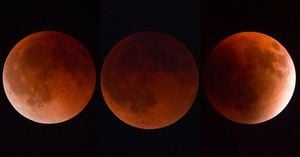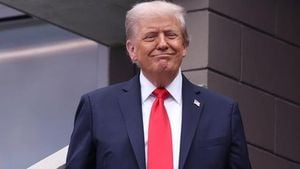The Russian ruble has been making headlines lately, and it’s not the kind of attention the Kremlin would like. With reports indicating the currency dropped to its lowest value since the onset of the Ukraine invasion, Russian citizens are bracing for tough times ahead. The recent plunge, which has seen the ruble trading around 114.5 against the US dollar, reflects the growing economic turmoil as Western sanctions and inflationary pressures bite harder.
President Vladimir Putin’s administration has been trying to downplay the economic fallout. Dmitry Peskov, the Kremlin’s spokesperson, reassured citizens stating, “Russians won’t notice the dollar exchange rate increase because they are paid in rubles.” But as many know, rising prices on everyday goods tell another story.
Indeed, the ruble’s decline is closely tied to soaring inflation. Basic commodities such as potatoes and butter have become significantly more expensive, contributing to widespread economic distress. To counter this spike, the Russian Central Bank has responded by raising interest rates dramatically, from 7.5% earlier this year to a staggering 21% by late October 2024. This aggressive strategy aims to rein in inflation, yet the results have been mixed.
Even with these measures, inflation continues to push consumer prices higher, reporting over 8% year-on-year as of November. It raises the question: can the Russian economy, already strained from military expenditures, maintain its current war efforts?
Experts are divided on this issue. Some, like Anders Åslund, a Swedish economist focused on post-Soviet states, argue the situation is dire. He stated, “Russia is currently facing an impossible economic conundrum caused by the rapid increase in military expenditures and the Western sanctions.” Despite Putin’s plans to ramp up military spending to 176 billion dollars by 2025, the nation seems limited with reserves dwindling and few willing to extend credit.
Åslund pointed out the constraints on financing war efforts, noting, “At the end of March 2024, its liquid resources amounted to only $55 billion. Nobody lends money to Russia.” The stark reality is evident: as economic pressures tighten, maintaining this war footing could become untenable.
On the flip side, some analysts like Sergei Aleksashenko, another economist who now resides in the U.S., caution against overestimulating the economic woes. He maintains, “Putin’s economic problems shouldn’t be overestimated. He will spend as much money on the war as necessary.” Such sentiment hints at the Kremlin's commitment to sustain military operations, even at the expense of civilian needs.
The Russian government’s approach is backed by the assertion of Turkey's potential role. If new U.S. President Donald Trump’s team moves forward with plans to increase oil output and suppress prices, Russia could face another financial hurdle, potentially endangering its reliance on oil revenue.
One area of concern is the current economic metrics. The Central Bank projected moderate growth with GDP rates around 3.5% for 2024, yet fears of stagnation linger as inflation persists, constraining consumer spending and investment. Last year, the economy saw growth attributed largely to military spending. Moving forward, analysts expect growth to slow down significantly by 2025.
Inflationary pressures have caused the ruble’s purchasing power to erode drastically. Recent figures suggest the currency had depreciated to 108 per dollar by late November, marking significant economic distress. This decline has prompted the Central Bank to act, with new sanctions exacerbated by the U.S. targeting major Russian banks, including Gazprombank, which is integral to energy transactions.
Putin’s measures have led to discussions about long-term economic stability. The Bank was faced with the task of balancing budget limits against rising defense costs. For 2024, the expected deficit could reach 3.1 trillion rubles, raising questions about sustainability.
Further complicate matters, the Central Bank’s tight monetary policy is causing backlash from industrial sectors close to the government, including defense manufacturing. CEO of Rostec, Sergei Chemezov, has voiced concerns over high-interest rates, stating, “If we continue working this way, most enterprises will go bankrupt.” His comments reflect broader concerns within the military-industrial complex about the future of high-tech products, which take longer to produce and become more susceptible to economic pressures.
Meanwhile, recent predictions indicate the Central Bank's current financial strategies could lead to stagnation, especially if inflation rates continue climbing unchecked. The potential for stagflation — slow growth alongside high inflation — has not escaped the notice of economists. Some specialists, including Alexandra Prokopenko from the Carnegie Russia Eurasia Center, have suggested, “It’s not stagflation yet, but Russia is close.”
Despite concerns about the economy cooling, the military sector remains strong. Analysts argue this growth is concentrated primarily within military supply and production sectors, with little sign of recovery elsewhere. Russian economists have warned of negative consequences as this trend continues, emphasizing the need for immediate policy shifts to stabilize the economy.
With public discontent simmering over inflation and economic instability, the weight of military strategy on the civilian economy is becoming harder for the Russian government to ignore. Consequently, opposition voices, including Vladimir Milov, are echoing the need for change — advocating for ending the conflict to alleviate economic distress. “The only way out is to finish the war and withdraw Russian troops from Ukraine,” he suggested.
With tensions still high and the ruble’s future uncertain, the Kremlin's next moves remain pivotal. Will the government prioritize military spending at the cost of national stability, or will it seek new solutions to restore economic balance? The ruble’s relentless decline serves as both symbol and catalyst for the challenges facing contemporary Russia.



